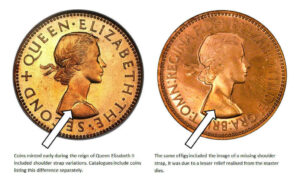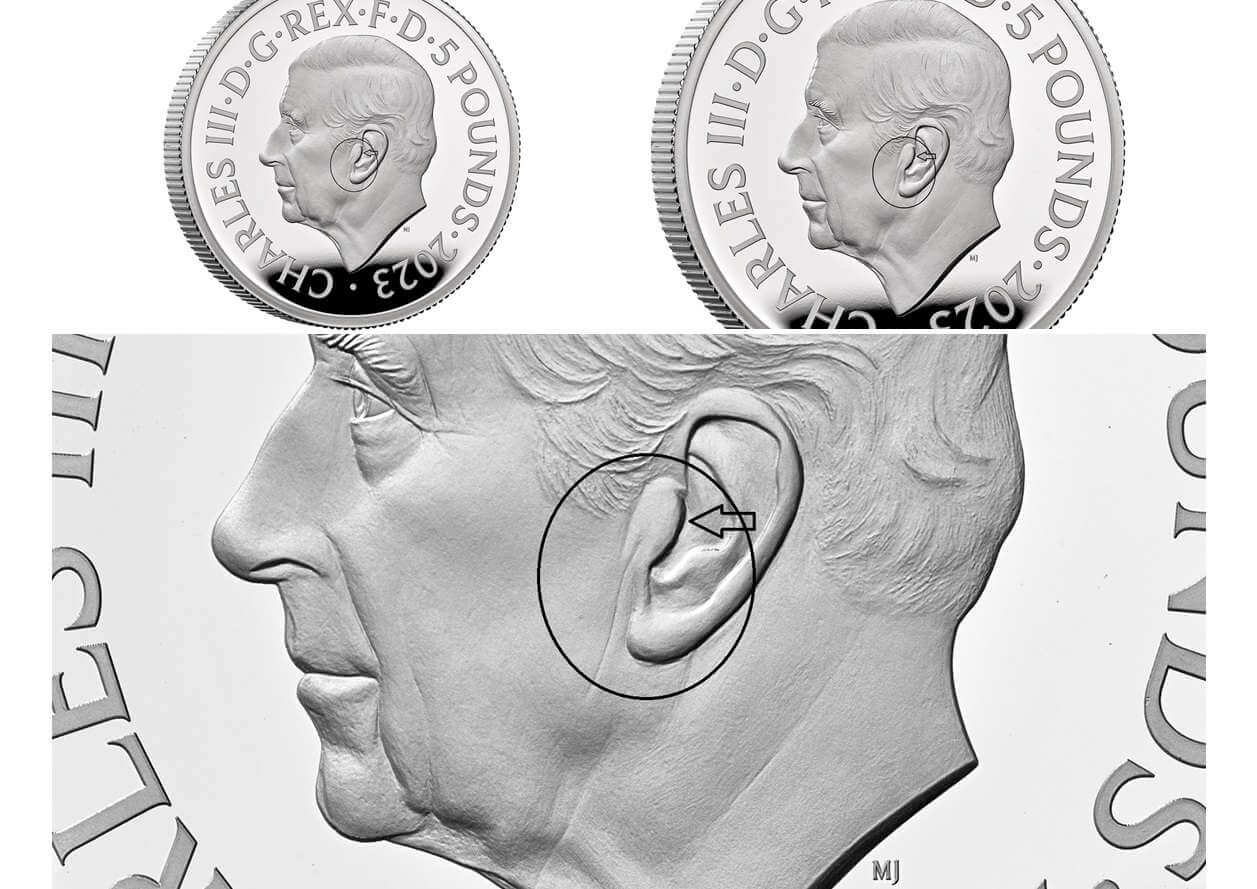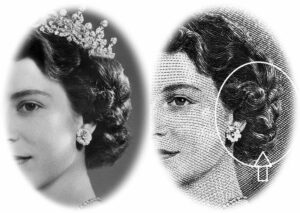A Little Birdie Told Me…
It isn’t very often that a story in the numismatic world makes it into mainstream news so, whenever this does occur, those of us who cover coins specifically want to find out what happened and why. Recently, it was revealed that there was a unique peculiarity involving the new King’s likeness which has already begun to be included onto Britain’s national coinage. These days, whenever there is mention of anything having to do with the Royal family, one assumes it has something to do with the more notorious members appearing on chat shows in an effort to publicize so-called “tell-all” books. However, in this case, it involves the sighting of a bird along with King Charles III and, under very unusual circumstances.
A Queen on Tens of Billions of Coins
For a little more background on the story, let’s go back just a few months to the 8th September last year, when not only the United Kingdom and Commonwealth but the world lost one of the most extraordinary heads of state. Queen Elizabeth II passed away unexpectedly and despite the fact she was ninety six years of age, the announcement of her death stunned many. Last June, the nation had embarked on celebrations marking the Queen’s Platinum Jubilee, Elizabeth II had reached seventy unprecedented years on the throne and no other monarch had achieved such a milestone anniversary. She had presided over seven decades of change and was the only British monarch which more than three-quarters of the world’s population had ever known.
During the ensuing weeks after the Queen’s death, questions of when and how the United Kingdom and Commonwealth would transition state emblems from the Late Queen to her successor, Prince – now King Charles III. Those “in the know” were already aware that preliminary portraits of the Prince of Wales had been prepared which were meant to be transitioned into workable effigies for use on coinage. This was done in the event the Sovereign passed away unexpectedly and, if rumor is to be believed, the process took place when Queen Elizabeth II had marked her ninetieth birthday. As such, a proposed effigy was likely prepared in 2016 when King Charles III was himself almost sixty eight years old. It is estimated by many in the industry that Queen Elizabeth II’s image has adorned more coins, banknotes and stamps than any other human in history. Literally tens of billions of coins were minted all over the world from 1953, the year of the Queen’s coronation. In the UK alone, the Royal Mint estimates nearly twenty six billion coins carrying four of the Queen’s five effigies are presently in circulation. Days after Queen Elizabeth II had been buried in Windsor Castle’s Chapel alongside her husband the late Duke of Edinburgh, the world saw for the first time the finalized effigy of His Majesty King Charles III. Released by the Royal Mint on the 30th September, the announcement outlined that the portrait would be used only on all British coinage from the end of 2022. The Royal Mint had commissioned esteemed sculptor Martin Jennings to create a likeness of Charles III which would see the new King facing to the left in opposite direction from the previous monarch, a tradition established since the restoration of the British monarchy in 1660. For most of the public who had seen the King’s coin image for the first time, the overall opinion was favorable, the resemblance was near enough and the Royal Mint confirmed circulation quality 50 pence coins were in production for release before Christmas. The process was now well underway to ultimately introduce a new chapter of British coinage that included a change in monarch since 1953.
An Unexpected Guest
However… upon closer inspection by some eagle-eyed coin collectors, it seems the King is sharing the space – or spotlight on his coins with what some have described as an unexpected guest. Perching right up to the ear of the King is the clear outline of a bird – and as many have observed, once seen is never “un-seen”! The King’s effigy unmistakably depicts this small bird with a sweeping long tail perched right along the ear of the King. It isn’t yet known whether the Royal Mint, Mr. Jennings whose work this is or even the King himself is aware of the “inclusion”. So far, those who have focused on the bird have had fun posting in online chat rooms with suggestions as to what the “little birdie” might be whispering into the ear of the King. The suggestions have ranged from comical to serious and even offering advice on how to handle unruly or petulant members of his immediate family. The phrase “a little bird told me” comes to mind and has taken on a new meaning or life of its own.
Some humorous members of the public have suggested that hopefully the King will heed the bird’s wise advice such as keeping controversial opinions to himself… After all, the bird can’t do worse than the King’s advisors. As it is well-known Charles III has a particular affinity for nature and protecting the planet from global-warming, perhaps the little birdie is suggesting the King lead by example, limit his globe-trotting and the use of carbon-producing jet airplanes. Another contentious subject is wind power but, as these large propeller-rigged generators are known to kill many birds in-flight, Charles III might be on the receiving end of a beak-full of complaints and criticism. As Prince of Wales, the insignia of the heir to the throne are three Ostrich plumes gathered by a coronet – it is understandable that the bird might be asking for an explanation of just where these plumes came from!
The Queen and the Devil
Fast-forward nearly seventy years and banknote collectors are reminded of a particularly troubling portrait of a young Queen Elizabeth II. When the “bird” story began making rounds in limited numbers of publications, it brought to mind for many the decades-old story of a “hidden” image in the hairstyle of Queen Elizabeth II as she was depicted on Canadian banknotes. The Bank of Canada chose an image of the Queen to include on all denominations of banknotes from 1954 and before long, it was reported the image of a “Devil’s head” could clearly be seen in the Queen’s curls – step back a couple paces, you’ll see it. Ultimately the story which also included many conspiracies as to how the image was over-looked had gained so much steam in the mainstream media, the Bank of Canada eventually amended the Queen’s hair to eliminate any traces of the face. As the Bank of Canada’s Museum currently posts on their website “After 1957, the series was entirely free of questionable images or of any faces but that of the Queen.”

The “shoulder strap” and “no shoulder strap” variations on the Queen’s effigy created by Mary Gillick in 1953.
Here to Stay?
In any event, now that the Genie is out of the bottle or, the bird is out in the open and as the story gains more traction in the mainstream media, it’ll be interesting to ascertain whether the appearance of a bird on the King’s ear is as troubling as an image of Lucifer in the Queen’s hairstyle was. Will the bird perched on the ear of the King become so distracting that it results in re-tooling the effigy? In terms of coin collecting, it’s always a welcome option to see differences such as “shoulder strap” and “no shoulder strap” variations such as what had occurred on the Queen’s effigy created by Mary Gillick in 1953. I expect on this occasion that won’t happen and it is not likely we will see “ear bird” and “no ear bird” variations. Should the King sit on the throne for another fifteen years or more, it is likely we will see an entirely new effigy in 2038 rather than an amended one in 2023. However, a little birdie has told me that this feathered friend of King Charles III in all likelihood will sooner or later take on a life of its own in the age of social media and digital news. I foresee a Facebook or Twitter (how appropriate) page all its own with daily updates of all things royal, or numismatic – maybe both. Move over Harry and Meghan and make way for the newest media star with even closer ties to royalty and the King – not to mention greater appeal, discretion and panache!
The author, Michael Alexander is president of the London Banknote and Monetary Research Centre.
Read more about the changeover of coins and banknotes from Elizabeth II. to Charles III.






